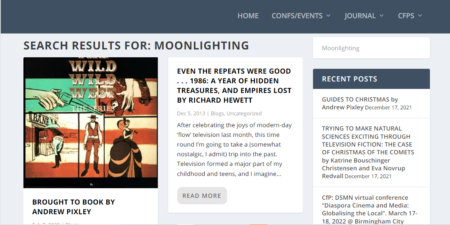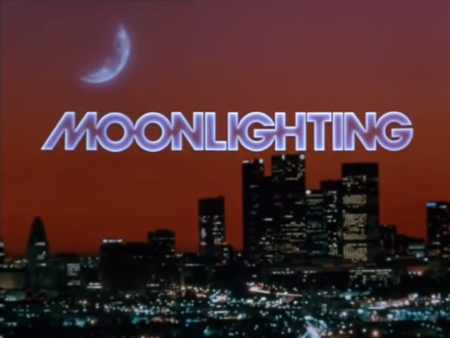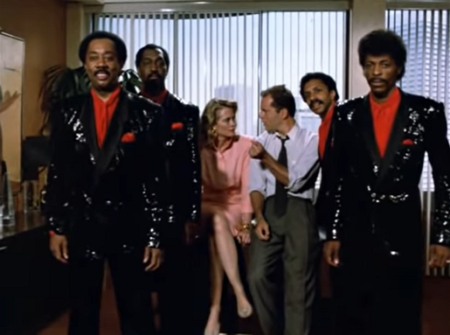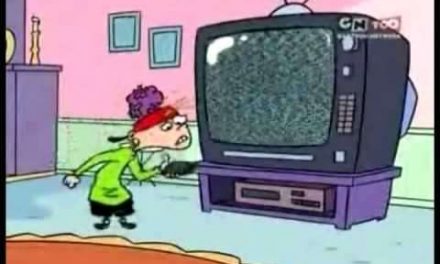About two years ago on this very blog, I ruminated on the disproportionate distribution of books and television series, and while attempting to celebrate some of the very tomes that had been issued over the year, I also grumbled about many other important series that had been overlooked.
‘[W]hy can’t I get a decent book about Moonlighting (1985-1989)?’ I moaned about a third of the way down the text. Sadly, books on Moonlighting just didn’t seem to happen that often…
As I noted, I did have a book on Moonlighting. Still do. It’s called Cybill & Bruce: Moonlighting Magic, and it was published in May 1987 by St Martin’s Press. I purchased it in August 1987 at the World’s Biggest Bookstore in Toronto [1] which I was taken to by my dear friend Hilary McPhail. I met Hilary in my first week of academic life, and by the time you read this we’ll both be retired – and in between these two events she’s enriched my life in so many ways. Thanks Hilary!
Anyway, written by Barbara and Scott Siegel Cybill & Bruce: Moonlighting Magic came with the strapline ‘Sexy! Sizzling! Sensational!’ This little paperback was basically one-third biography on Moonlighting established star Cybill Shepherd, one-third biography on Moonlighting upcoming star Bruce Willis, and one-third appreciation of the series with key episode reviews, press comments and a few nice quotes from the people who made it. For a popular piece, it was pleasant enough… but I wanted more…
For those of you who have never paid a visit to the Blue Moon Detective Agency over the past 35 years or so… well, you’re missing out. Moonlighting started off as one thing and then turned into a whole series of other things. At the outset, it was a caper adventure series with contrasting uptight female and louche male characters thrown together in an uneasy business alliance to take on private investigation cases. Former affluent model Maddie Hayes (Cybill Shepherd) had her wealth embezzled by her accountant, leaving her only asset in the form of a tax-write off – the lacklustre City of Angels Detective Agency run by goofball David Addison (Bruce Willis). And during one of the best TV pilot films I’ve ever enjoyed watching, the two work together to solve a murder in an engaging comedy-drama that captured the character energy of screwball hokum such as His Girl Friday (1940).
The initial episodes were highly enjoyable investigative assignments crammed with thrills and wisecracks as Maddie and David argued their way through various homicide cases with bubbling character chemistry. By the second series, the adventures were becoming increasingly wacky… crazy chases with everyone garbed in black veils and dresses to the breathless strains of the William Tell overture, historic homicides with the cast adopting 1940s roles in sequences filmed in black-and-white and introduced by Orson Welles, the characters emerging from their studio set to celebrate Christmas with the show’s crew, and a season finale which comprised a chase through the lot on which the series was shot. By the third season, Maddie and David frequently spoke to the audience at home and would as likely be engaged in a heart-breaking drama playing out in their own complicated lives as tracing down a criminal miscreant for a client; The Temptations turned up to demonstrate to Maddie ‘How to be Funky’, the expectation-confounding background to David’s broken marriage was revealed via an imaginary dance sequence to Billy Joel’s Big Man on Mulberry Street (1986), a young Moonlighting fan was forced to do his Shakespeare homework by his mum and so imagined The Taming of the Shrew (c 1590) with rock music played out by David and Maddie, a gossip columnist arrived at the office to investigate why – yet again – there was no new episode ready to air on ABC… and finally, after three seasons, the David-Maddie relationship reached critical point.
Then it goes weirder still – Maddie and David aren’t together much of series four, so we have episodes framed like editions of the once-revered sitcom The Honeymooners (1955-1956), an interlude depicting the Blue Moon owners in Claymation, a two-parter with a Gilbert and Sullivan musical sequence, an appearance of legendary 1950s crooner Pat Boone as a future David, and a season finale which – thanks to a writers’ strike – concluded with an improvised musical number. Then the fifth and final season, opening with a heart-breaking instalment surrounding the child in Maddie’s womb being briefed about his prospective parents by his guardian angel and concluding with an edition in which the characters discover that their show has been cancelled and seek salvation from both television producers and religion before the final closing credits roll.
How can you not want to watch that?
And yet while this show was so big, probably one of the biggest of its day, it’s now largely forgotten. Not currently on streaming platforms [2] that I’m aware of, and the DVD sets have long since been and gone.
Nor does it feature much in academia. In April 2015 when Dr Bianca Mitu mentioned Moonlighting during a superb paper about the now equally-forgotten BBC Two venture Vexed (2010-2012) at Forgotten, Lost & Neglected TV Drama, it was my wife (whom you’ll meet again in a few paragraphs’ time as her seasonal alter-ego) and myself who whooped with delight at the back as David and Maddie appeared on the screen. Sorry Bianca. I know I apologised at the time, and here I am seven years later apologising again. Hope you’re happy and well in academia-land.
I mean, Moonlighting is barely even mentioned on CSTonline itself. Go on, have a search for it! You know, using that handy ‘Search’ function? Yes, you do. It’s the box in the top right corner of where you are now with SEARCH… in it! Honestly, give me strength… I sometimes think that there should be courses given in how to use Search functions. People so seldom bother, and Tobias has gone to all the trouble of making sure it’s installed there for you to use… So, go on, type in ‘Moonlighting’, press return and see what happens.
Done it? Okay – so, only two results [3]. Looking a bit like this.

Fig 4: In fact, exactly like this.
So, you can ignore what I said and look at Richard Hewett’s Even the Repeats were Good… 1986: A Year of Hidden Treasures, and Empires Lost. Richard notes of Moonlighting that ‘it […] deserves a far more prominent place in television histories than it has thus far been accorded’. And he’s a proper television academic. So, you know, you should pay attention to him.
Well, now, the good news. I now have got a decent book about Moonlighting. Thanks to Santa. She not only secured me a copy of La La Land’s The Time Tunnel: Volume Two (which has already had several most enjoyable listens), but she also presented me with Moonlighting: An Oral History by Scott Ryan (2021). Good old Santa!
This really is a terrific read – one of the utter delights of my festive week. And I’m in awe with what Scott’s done here because it’s such an exquisite assembly of interviews and comments from the people who made Moonlighting. Now, this is an area that I tend to shy away from in my own writing and researches. I know that people who make television are every bit as nice and kind as people who don’t make television, but I still feel that – as an ‘outsider’ – I can’t really do them justice when I communicate with them, so I tend to stick to paperwork. I get a bit frightened that I’ll discover that the happy shows I’ve enjoyed weren’t that happy after all… and that my delight was at the cost of other people being made miserable.
And – goodness – Moonlighting was an emotional roller-coaster on-screen and off. I think we knew that a bit at the time, but I don’t think I’d seen it conveyed so potently until I read Scott’s amazing assembly of memories from a dazzling array of perspectives – stars, co-stars, producers, writers, directors, editors and all manner of other key people who crafted the Blue Moon investigations that I was addicted to all those years ago.
Scott’s approach is particularly appreciated in that it’s raw and unedited. Accounts of events given by those involved are on occasion contradictory – and that tells you even more about the events and the people present, as their own words paint the picture of conflicting perspectives. Some of it is brutal reading. In the same way that Maddie and David’s on-screen relationship and the imagination with which their cases were presented appeared like a whirlwind, burnt bright, went critical and descended into an emotive and traumatic mire, the circumstances of fame and life in general slammed into those making the show in a manner that was equally amazing and upsetting.
And somehow it has all the energy, all the wisecracks, all the romance, all the thrills of watching David and Maddie all those years ago. A perfect use of the fiction to uncover the fact behind it, and to make me admire some of the talented people who made this rule-breaking show a little bit more than I already did.
It’s a helluva read. And well worth the wait!
At New Year, my wife and I were just debating on what we’d like to start watching as a Saturday night treat with pizza. And we’re pretty sure that we’ll be visiting the Blue Moon detective agency for the first part of 2022.
Thanks Santa.
Anyway, Moonlighting book. Tick. Job done. So, where’s the one on Hill Street Blues (1981-1987) got to?
Andrew Pixley is a retired data developer. For the last 30 years he’s written about almost anything to do with television if people will pay him – and occasionally when they won’t. Oh, Santa was also kind enough to acquire for him another beautiful specialist item from the Dragon’s Friendly Society: The Sagas of Noggin the Nog. He really does think that she’s the most wonderful Santa he could wish for.
Footnotes
[1] Now sadly no longer with us. The World’s Biggest Bookstore that is, not Toronto.
[2] Whatever they may be.
[3] Information correct at time of writing. I dearly hope that if you’re reading this at some point in The Future that there’s more than two hits coming back to you.










Andrew!
I totally agree. Moonlighting was a great show and deserves to be written far more about. Much easier to do this if I can find copies of it…
But it does need to be revisited, I remember it as being hilarious and heart-wrenching.
Hope all is well with you all.
John R
Hello John 🙂
Happy New Year! Hope you and the family are warm and safe and well and had the best festive season given whatever circumstances you encountered.
My first response didn’t seem to register, so I’ll try to reproduce it as best as I can…
“Moonlighting” was SOOOOO BIG… and then seemed to vanish. Around 1986/1987 it was so talked about – even in the UK – and then… nothing. I seem to recall that the VHS tape of the pilot episode was one of the first sell-throughs to crack down through the £10 barrier; it was everywhere, lying there enticingly at £9.99.
Getting to see it these days isn’t easy. Thankfully, my wife and I bought all four DVD boxes when they were issued… but some of these now go for higher prices than when they originally appeared. I think the last Freeview screening in the UK was about 17 years ago or so, and I don’t believe it’s on any streaming platform. And, naturally, I’ve never ever suggest finding illicit copes (even although I’m sure Googling something along the lines of “Moonlighting” and “Series” and “Video” would probably sort you within seconds).
We’re now up to the first three episodes of Season Two … and loving it! (As Maxwell Smart would say). It stands up very well, but with certain elements that I doubt people would use now. At it *is* still hilarious and heart-wrenching.
And all is good well with us thanks – a comparatively boring life, but one which allows my wife and I to cosy down on the sofa to spend time with Maddie and David… and Maddie and Jonathan, and Horace Rumpole, and Supervising Officer Leigh Henry, and DI Neville Parker, and all at 165 Eaton Place. It’ll do. 🙂
All the best
Andrew
I couldn’t agree more. Moonlighing did ‘postmodern television’ when pomo was really happening and it was a big hit too at the same time. Long before Twin Peaks. Not sure why it’s so neglected. It’s still very watchable. It all got a bit of a mess when they became a couple but every series ‘jumps the shark’ at some point
Hello Aris 🙂
It’s certainly one of the earliest television drama-comedy series in which the characters seemed to *know* that they were in a television series – certainly of that size anyway. I supposed that “The Strange World of Gurney Slade” is some 25 years or so ahead of it in some respects… but “Moonlighting” does take it to another level.
So many shows *do* seem to just vanish the moment they’re no longer hot. And I seem to recall that even after it ‘jumps the shark’ there’s still a lot to admire (“Womb with a View” being a startling piece of TV). And indeed, with a great show, even when they have ‘jumped the shark’, there’s often still a lot to enjoy. People still claim that “Hill Street Blues” isn’t really worth watching after Phil Esterhaus dies… and yet there’s still some wonderful television in those later seasons.
Hope this finds you well.
All the best
Andrew
Happy to see that both Moonlighting and the World’s Biggest Bookstore are still remembered. This book by Scott Ryan sounds most interesting, especially the contradictory parts! Thank you for the article. And thank you to Santa for her choice of gifts.
Hello Hilary 🙂
Both certainaly remembered most happily by me – and the miracle of DVD allows us to relive one if not the other.
Scott’s book is rather super. In fact, as it turns out, Santa has actually snaffled the book back and is now reading it herself (she’s up to the Orson Welles bit).
And – yes – she really is the most amazing Santa that I could wish for.
All the best
Andrew
(Oh, and for people who aren’t Hilary or haven’t met Hilary – like many people whom I mention in these blogs, Hilary is one of those massively amazing people that you’re so glad is part of your life when you’ve met her. She made the first weeks of university so much less daunting and less frightening for me… since when she’s one of those people who shares and challenges, engaging with enthusiasm and always offering up new things that you might want to try. Some of the series that I’ve enjoyed most have entered my life via her recommendation. I owe her a very great deal)